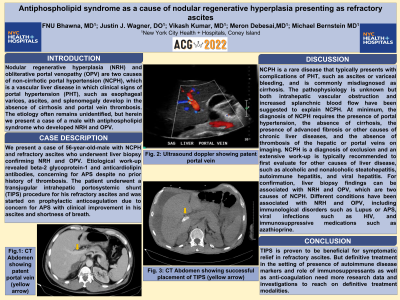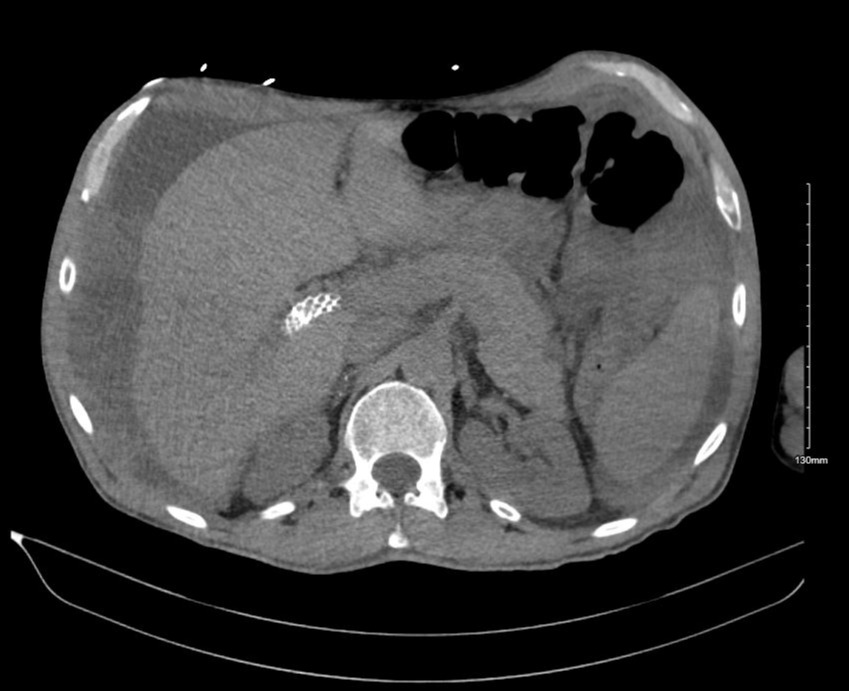Back


Poster Session D - Tuesday Morning
Category: Liver
D0548 - Antiphospholipid Syndrome as a Cause of Nodular Regenerative Hyperplasia Presenting as Refractory Ascites
Tuesday, October 25, 2022
10:00 AM – 12:00 PM ET
Location: Crown Ballroom

Has Audio

Fnu Bhawna, MD
Coney Island Hospital
Brooklyn, NY
Presenting Author(s)
Fnu Bhawna, MD1, Justin J. Wagner, DO1, Vikash Kumar, MD2, Meron Debesai, MD1, Michael Bernstein, MD1
1Coney Island Hospital, Brooklyn, NY; 2The Brooklyn Hospital Center, Brooklyn, NY
Introduction: Nodular regenerative hyperplasia (NRH) and obliterative portal venopathy (OPV) are two causes of non-cirrhotic portal hypertension (NCPH), which is a vascular liver disease in which clinical signs of portal hypertension (PHT), such as esophageal varices, ascites, and splenomegaly develop in the absence of cirrhosis and portal vein thrombosis. The etiology often remains unidentified, but herein we present a case of a male with antiphospholipid syndrome who developed NRH and OPV.
Case Description/Methods: We present a case of 56-year-old-male with NCPH and refractory ascites who underwent liver biopsy confirming NRH and OPV. Etiological work-up revealed beta-2 glycoprotein-1 and anticardiolipin antibodies, concerning for APS despite no prior history of thrombosis. The patient underwent a transjugular intrahepatic portosystemic shunt (TIPS) procedure for his refractory ascites and was started on prophylactic anticoagulation due to concern for APS with clinical improvement in his ascites and shortness of breath.
Discussion: NCPH is a rare disease that typically presents with complications of PHT, such as ascites or variceal bleeding, and is commonly misdiagnosed as cirrhosis. The pathophysiology is unknown but both intrahepatic vascular obstruction and increased splanchnic blood flow have been suggested to explain NCPH. At minimum, the diagnosis of NCPH requires the presence of portal hypertension, the absence of cirrhosis, the presence of advanced fibrosis or other causes of chronic liver diseases, and the absence of thrombosis of the hepatic or portal veins on imaging. NCPH is a diagnosis of exclusion and an extensive work-up is typically recommended to first evaluate for other causes of liver disease, such as alcoholic and nonalcoholic steatohepatitis, autoimmune hepatitis, and viral hepatitis. For confirmation, liver biopsy findings can be associated with NRH and OPV, which are two causes of NCPH. Different conditions have been associated with NRH and OPV, including immunological disorders such as Lupus or APS, viral infections such as HIV, and immunosuppressive medications such as azathioprine.
Pursuing TIPS earlier in the setting of refractory ascites, as well as offering anticoagulation therapy for patients with possible APS to prevent the development of potential thromboses, could be appropriate recommendations to prevent complications in the disease course. This case report highlights the need for further investigations on the etiologies, diagnosis pathways, and treatment options for NCPH.

Disclosures:
Fnu Bhawna, MD1, Justin J. Wagner, DO1, Vikash Kumar, MD2, Meron Debesai, MD1, Michael Bernstein, MD1. D0548 - Antiphospholipid Syndrome as a Cause of Nodular Regenerative Hyperplasia Presenting as Refractory Ascites, ACG 2022 Annual Scientific Meeting Abstracts. Charlotte, NC: American College of Gastroenterology.
1Coney Island Hospital, Brooklyn, NY; 2The Brooklyn Hospital Center, Brooklyn, NY
Introduction: Nodular regenerative hyperplasia (NRH) and obliterative portal venopathy (OPV) are two causes of non-cirrhotic portal hypertension (NCPH), which is a vascular liver disease in which clinical signs of portal hypertension (PHT), such as esophageal varices, ascites, and splenomegaly develop in the absence of cirrhosis and portal vein thrombosis. The etiology often remains unidentified, but herein we present a case of a male with antiphospholipid syndrome who developed NRH and OPV.
Case Description/Methods: We present a case of 56-year-old-male with NCPH and refractory ascites who underwent liver biopsy confirming NRH and OPV. Etiological work-up revealed beta-2 glycoprotein-1 and anticardiolipin antibodies, concerning for APS despite no prior history of thrombosis. The patient underwent a transjugular intrahepatic portosystemic shunt (TIPS) procedure for his refractory ascites and was started on prophylactic anticoagulation due to concern for APS with clinical improvement in his ascites and shortness of breath.
Discussion: NCPH is a rare disease that typically presents with complications of PHT, such as ascites or variceal bleeding, and is commonly misdiagnosed as cirrhosis. The pathophysiology is unknown but both intrahepatic vascular obstruction and increased splanchnic blood flow have been suggested to explain NCPH. At minimum, the diagnosis of NCPH requires the presence of portal hypertension, the absence of cirrhosis, the presence of advanced fibrosis or other causes of chronic liver diseases, and the absence of thrombosis of the hepatic or portal veins on imaging. NCPH is a diagnosis of exclusion and an extensive work-up is typically recommended to first evaluate for other causes of liver disease, such as alcoholic and nonalcoholic steatohepatitis, autoimmune hepatitis, and viral hepatitis. For confirmation, liver biopsy findings can be associated with NRH and OPV, which are two causes of NCPH. Different conditions have been associated with NRH and OPV, including immunological disorders such as Lupus or APS, viral infections such as HIV, and immunosuppressive medications such as azathioprine.
Pursuing TIPS earlier in the setting of refractory ascites, as well as offering anticoagulation therapy for patients with possible APS to prevent the development of potential thromboses, could be appropriate recommendations to prevent complications in the disease course. This case report highlights the need for further investigations on the etiologies, diagnosis pathways, and treatment options for NCPH.

Figure: Ascites with visible transjugular intrahepatic portosystemic shunt.
Disclosures:
Fnu Bhawna indicated no relevant financial relationships.
Justin Wagner indicated no relevant financial relationships.
Vikash Kumar indicated no relevant financial relationships.
Meron Debesai indicated no relevant financial relationships.
Michael Bernstein indicated no relevant financial relationships.
Fnu Bhawna, MD1, Justin J. Wagner, DO1, Vikash Kumar, MD2, Meron Debesai, MD1, Michael Bernstein, MD1. D0548 - Antiphospholipid Syndrome as a Cause of Nodular Regenerative Hyperplasia Presenting as Refractory Ascites, ACG 2022 Annual Scientific Meeting Abstracts. Charlotte, NC: American College of Gastroenterology.
